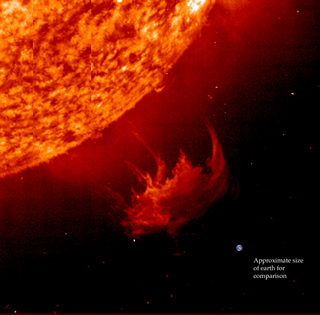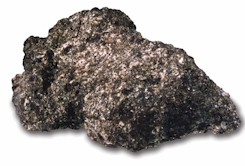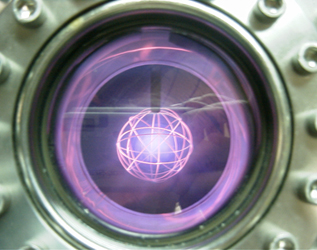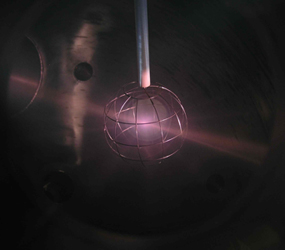|
Mainland High School
Cutting the Cord: ISTF 07-1726 |
||||||
|
Home
Introduction Components One Two  Product Product
Three Microwave Research W. C. Brown Generators History Phased Arrays Properties Rectennas Semiconductors Solar Satellites Superconductors Moon Research Colonization Helium-3 Fusion Geography Mining Resources Project Assessment Bibliography Glossary Team |
Helium-3
Solar wind is the formation of charged particles emitted from the corona of the sun. The speed of solar wind has been noted to move as fast as 900 kilometers per second. The Aurora Borealis is an example of a solar wind that you can see from the Earth when light is emitted as the gas atoms in our atmosphere are excited by the charged particles. Geomagnetic storms are caused by solar winds which can temporarily knock out the power grids located on the Earth. When the moon is struck by solar wind, the charged particles leave behind Helium-3 in the outermost surface layer of the moon. Later on meteorites striking the moon's surface plow the Helium-3 into deeper layers acting as tillers exposing more of the moon's layers to Helium-3. Every sample that has been extracted from the moon has had trace amounts of Helium-3. Some samples have been extracted a meter deep into the surface of the moon and Helium-3 has still been found.
Helium-3 is a rare isotope, having two protons and only one neutron, of commonly found Helium-4. The special part about 3He is that it is extremely receptive to fusion reactions which produce a massive amount of energy with little residual radioactivity. We have not had the ability to do this before because the earth lacks this isotope since our atmosphere blocks solar winds which contain the 3He. The moon on the other hand is abundant with it. Scientists estimate that there is about one million tons of Helium-3 on the moon, imbedded in an ore called ilmenite, which is enough to power the entire world for thousands of years. To liberate the Helium, the ore has to be heated to about 700-800 degrees Celsius. Unfortunately gathering enough moon dust to produce sufficient amounts of 3He could be a major obstacle. The substance is scattered all across the moon's surface, and is not highly concentrated. To obtain 70 tons of 3He, millions of tons of moon dust would have to be gathered and purified. The estimated cost to transfer the helium between Earth and the moon is roughly 40,000 to 60,000 dollarís per kilogram where it has been estimated that 3He has a cash value of 5.7 million dollarís per kilogram. These prices would make a trip to the moon well worth it. Helium-3 Fusion Reactor
Two Helium-3 atoms. when combined in a super heated plasma, fuse briefly to create an unstable molecule before breaking apart into a Helium-4 atom and two protons. The things produced when the unstable molecule breaks apart are traveling at extremely high speeds, so they carry a lot of energy. This produces 12.9 MeV (megaelectronvolts) of energy. One of the protons carries 8.9 MeV and the other carries 3.2 MeV, the remaining 0.8 MeV is carried by the Helium-4, an alpha particle. To be combined, the Helium-3 atoms must overcome their electrostatic repulsion because of the fact that the nuclei are both positively charged. When the nuclei come close enough together the stronger nuclear force pulls them together, creating the unstable atom. To make the nuclei come close enough together they must be moving very quickly. One of the most effective ways to do this is to make it into superheated plasma. Being superheated, their kinetic energy can get them close enough together. When superheated like this it must be contained magnetically. It is currently easiest to contain it is a Tokamak. There have been tokamaks that were able to produce temperatures high enough to start fusion, like the TFTR (Tokamak fusion test reactor). There has been a reactor designed specifically for third-generation Helium-3 fusion by Gerald Kulcinski at the University of Wisconsin. 
This reaction produces large amounts of energy with very little harmful by product. Kulcinski thinks that using a tokamak is overly expensive and complicated. Instead of using an electromagnetic field, his reactor uses an electrostatic field. Kulcinski's Inertial Electrostratic Confinement IEC reactor makes and contains a 10-cm sphere that can sustain Helium-3 fusion. He thinks that he can better collect the energy produced by these reactions by using a reverse particle accelerator that can convert the power directly into electricity without the need of turning a turbine.
EFDA-JET - About Tokamaks http://www.jet.efda.org/pages/faqs/faq2.html#3003 Lawrence Berkeley National Laboratory - ABC's of Nuclear Science http://www.lbl.gov/abc/Basic.html NASA Stargazers - Solar Winds and CMES http://stargazers.gsfc.nasa.gov/students/solar_winds_cmes.htm Northwestern University - What is solar wind? http://www.qrg.northwestern.edu/projects/vss/docs/space-environment/3-what-is-solar-wind.html Popular Mechanics - Mining The Moon http://www.popularmechanics.com/science/air_space/1283056.html?page=4 Princeton Plasma Physics Laboratory - Tokamak Fusion Test Reactor http://www.pppl.gov/projects/pages/tftr.html redOrbit - Glossary http://www.redorbit.com/education/reference_library/glossary/ SPACE.com - Researchers and space enthusiasts see helium-3 as the perfect fuel source http://www.space.com/scienceastronomy/helium3_000630.html Space Physics - Geomagnetic Storms Can Threaten Electric Power Grid http://www.agu.org/sci_soc/eiskappenman.html The Space Review - A fascinating hour with Gerald Kulcinski http://www.thespacereview.com/article/536/1 The Triunity Report - Thereís Helium-3 in them there Moon hills! http://www.direct.ca/trinity/helium3.htm University of Wisconsin-Madison - General Operation II http://iec.neep.wisc.edu/photopages/GeneralOpPicsII.htm University of Wisconsin-Madison - Inertial Electrostatic Confinement Fusion http://iec.neep.wisc.edu/operation.php University of Wisconsin-Madison - Progress and Research on 3He Fusion Reactions at UW-Madison http://fti.neep.wisc.edu/presentations/piefer_iec06.pdf (pg 3) |
|||||



